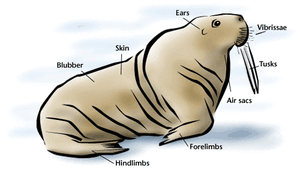
Walrus Anatomy
A walrus is perfectly suited for survival in the frigid Arctic. Short limbs, lots of blubber, and fat rolls provide excellent protection against the sub-zero weather. A walruses limited extremities guard against frostbite. The shortness of the limbs makes them easy to tuck under the body. The blubber is at least 15 centimeters thick, insulating the walrus from the cold. This high fat substance is largely composed of oil, which is why Natives use it for lamp oil. The walrus also has fat rolls, increasing surface area.
A walrus's mustache, or vibrissae, is used to detect clams and crustaceans at the bottom of the sea. The hairs are actually super-sensitive fibers that the walrus rubs along the ocean floor when hunting. It was previously believed that the tusks were used in eating, but this theory has been disproved.
The tusks are perhaps the most useful adaptation of a walrus. They are dramatically elongated upper canine teeth, not horns like some used to believe. These tools are used primarily for hauling a walrus's great girth out of the cold water. This action is where the scientific name Odobenus comes from. The word translates to "toothwalker". The tusks are also for fighting with other walruses. Although walrus tusks look menacing, the animals rarely hurt each other in disputes. The eyes and nose of a walrus are strategically positioned at the top of the head, so that the animal can peer out of the water with minimal exposure. This makes estimating the size of the walrus very difficult.
Two air sacs, along the walruses' neck, serve as life preservers for sleeping in the ocean. And yes, walruses can do that. These sacs are inflated with air to about the size of a beach ball (50 liters), and help keep the head of the walrus afloat. Walruses use the air sacs primarily on long migrations when sea ice is not present.